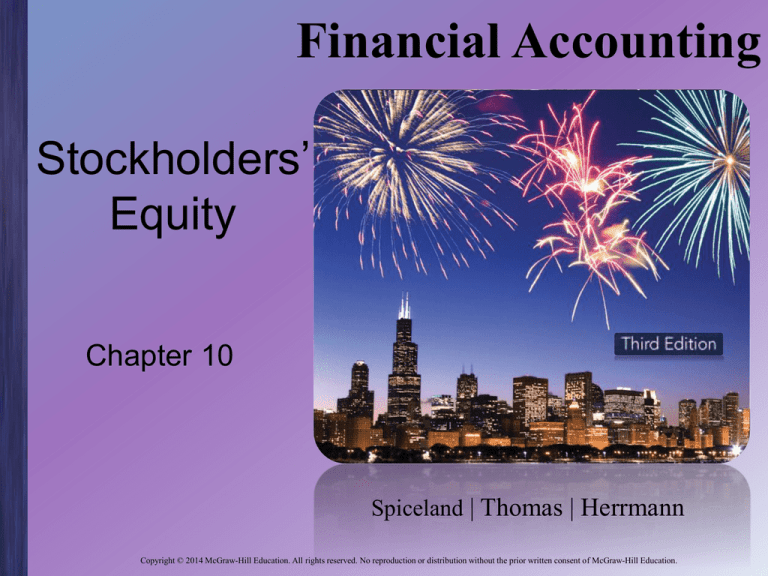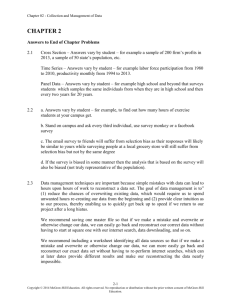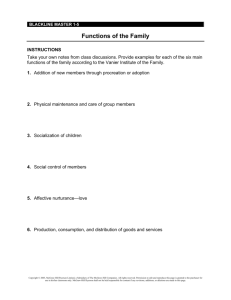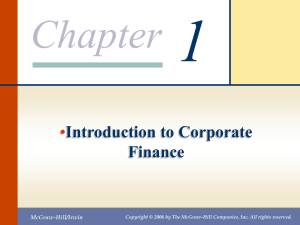
Financial Accounting
Stockholders’
Equity
Chapter 10
Spiceland | Thomas | Herrmann
Copyright © 2014 McGraw-Hill Education. All rights reserved. No reproduction or distribution without the prior written consent of McGraw-Hill Education.
10-2
Learning Objectives
• Identify the advantages and disadvantages of the
corporate form of ownership
• Record the issuance of common stock
• Contrast preferred stock with common stock and
bonds payable
• Account for treasury stock
• Describe retained earnings and record cash
dividends
Copyright © 2014 McGraw-Hill Education. All rights reserved. No reproduction or distribution without the prior written consent of McGraw-Hill Education.
10-3
Learning Objectives
• Explain the effect of stock dividends and stock
splits
• Prepare and analyze the stockholders’ equity
section of a balance sheet and the statement of
stockholders’ equity
• Evaluate company performance using information
on stockholders’ equity
Copyright © 2014 McGraw-Hill Education. All rights reserved. No reproduction or distribution without the prior written consent of McGraw-Hill Education.
10-4
Part A
Invested Capital
Copyright © 2014 McGraw-Hill Education. All rights reserved. No reproduction or distribution without the prior written consent of McGraw-Hill Education.
10-5
Learning Objective 1
Identify the advantages and disadvantages of the
corporate form of ownership
Copyright © 2014 McGraw-Hill Education. All rights reserved. No reproduction or distribution without the prior written consent of McGraw-Hill Education.
10-6
Corporations
• Articles of incorporation: corporate charter
describing:
• Nature of business activities
• Shares of stock to be issued
• Initial board of directors
• The board of directors establish corporate policies
and appoints officers who manage the corporation
Copyright © 2014 McGraw-Hill Education. All rights reserved. No reproduction or distribution without the prior written consent of McGraw-Hill Education.
10-7
Stages of Equity Financing
• Corporations first raise money from founders of
the business, friends, and family
• To grow, companies seek investments from:
• Angel investors
• Venture capital firms
• Initial public offering (IPO)
Copyright © 2014 McGraw-Hill Education. All rights reserved. No reproduction or distribution without the prior written consent of McGraw-Hill Education.
10-8
Public or Private
Public
• Allows public investment
• Many shareholders
• Stocks trade on stock
exchanges or by overthe-counter (OTC)
trading
• Regulated by the (SEC)
• Examples—Wal-Mart,
Microsoft, Intel
Private
•
•
•
•
•
Does not allow investment
by the general public
Fewer stockholders
Stocks not traded in the
open market
Not regulated by the
(SEC)
Examples—Cargill
(agricultural commodities)
Koch Industries (oil and
gas), Chrysler (cars)
Copyright © 2014 McGraw-Hill Education. All rights reserved. No reproduction or distribution without the prior written consent of McGraw-Hill Education.
10-9
Learning Objective 2
Record the issuance of common stock
Copyright © 2014 McGraw-Hill Education. All rights reserved. No reproduction or distribution without the prior written consent of McGraw-Hill Education.
10-10
Common Stock
• Treasury stock: repurchased shares, included as
part of shares issued, but excluded from shares
outstanding
Copyright © 2014 McGraw-Hill Education. All rights reserved. No reproduction or distribution without the prior written consent of McGraw-Hill Education.
10-11
Par Value
• Legal capital per share of stock that’s assigned
when the corporation is first established
• Has no relationship to the market value today
Copyright © 2014 McGraw-Hill Education. All rights reserved. No reproduction or distribution without the prior written consent of McGraw-Hill Education.
10-12
Accounting for Common Stock
Issues
Copyright © 2014 McGraw-Hill Education. All rights reserved. No reproduction or distribution without the prior written consent of McGraw-Hill Education.
10-13
Learning Objective 3
Contrast preferred stock with common stock and
bonds payable
Copyright © 2014 McGraw-Hill Education. All rights reserved. No reproduction or distribution without the prior written consent of McGraw-Hill Education.
10-14
Preferred Stock
• Issued in addition to common stock to attract
wider investment
• Preferred stockholders have:
• First rights to a specified amount of dividends
• Preference over common stockholders in the
distribution of assets at the time of dissolution
• Most preferred stock does not have voting rights
Copyright © 2014 McGraw-Hill Education. All rights reserved. No reproduction or distribution without the prior written consent of McGraw-Hill Education.
10-15
Features of Preferred Stock
• Flexibility allowed in its contractual provisions
• Types:
• Convertible: shares can be exchanged for
common stock
• Redeemable: shares can be returned to the
corporation at a fixed price
• Cumulative: shares receive priority for future
dividends, if dividends are not paid in a given year
• Dividends in arrears - unpaid dividends
Copyright © 2014 McGraw-Hill Education. All rights reserved. No reproduction or distribution without the prior written consent of McGraw-Hill Education.
10-16
Learning Objective 4
Account for treasury stock
Copyright © 2014 McGraw-Hill Education. All rights reserved. No reproduction or distribution without the prior written consent of McGraw-Hill Education.
10-17
Treasury Stock
• Corporation’s own stock that it has reacquired
• Companies buy back their own stock for various
reasons:
•
•
•
•
To boost underpriced stock
To distribute surplus cash without paying dividends
To boost earnings per share
To satisfy employee stock ownership plans
Copyright © 2014 McGraw-Hill Education. All rights reserved. No reproduction or distribution without the prior written consent of McGraw-Hill Education.
10-18
Purchase of Treasury Stock
Copyright © 2014 McGraw-Hill Education. All rights reserved. No reproduction or distribution without the prior written consent of McGraw-Hill Education.
10-19
Illustration 10.11—Stockholders’ Equity
before and after Purchase of Treasury Stock
Copyright © 2014 McGraw-Hill Education. All rights reserved. No reproduction or distribution without the prior written consent of McGraw-Hill Education.
10-20
Reissuing Treasury Stock
Copyright © 2014 McGraw-Hill Education. All rights reserved. No reproduction or distribution without the prior written consent of McGraw-Hill Education.
10-21
Reissuing Treasury Stock
Copyright © 2014 McGraw-Hill Education. All rights reserved. No reproduction or distribution without the prior written consent of McGraw-Hill Education.
10-22
Part B
Earned Capital
Copyright © 2014 McGraw-Hill Education. All rights reserved. No reproduction or distribution without the prior written consent of McGraw-Hill Education.
10-23
Learning Objective 5
Describe retained earnings and record cash
dividends
Copyright © 2014 McGraw-Hill Education. All rights reserved. No reproduction or distribution without the prior written consent of McGraw-Hill Education.
10-24
Retained Earnings
• Earnings retained in the corporation and not paid
out as dividends
• Equals all net income, less all dividends
• Has a normal credit balance
• Accumulated deficit: a debit balance in retained
earnings
Copyright © 2014 McGraw-Hill Education. All rights reserved. No reproduction or distribution without the prior written consent of McGraw-Hill Education.
10-25
Dividends
• Distributions by a corporation to its stockholders
• Declaration date: date on which board of
directors declare the cash dividend to be paid
• Record date: specific date on which the company
will determine who will receive the dividend
(registered owners of stock)
• Payment date: date of the actual cash distribution
Copyright © 2014 McGraw-Hill Education. All rights reserved. No reproduction or distribution without the prior written consent of McGraw-Hill Education.
10-26
Recording Cash Dividends
Copyright © 2014 McGraw-Hill Education. All rights reserved. No reproduction or distribution without the prior written consent of McGraw-Hill Education.
10-27
Learning Objective 6
Explain the effect of stock dividends and stock splits
Copyright © 2014 McGraw-Hill Education. All rights reserved. No reproduction or distribution without the prior written consent of McGraw-Hill Education.
10-28
Stock Dividends and Stock Splits
• Stock dividends: additional shares of a company’s own
stock given to stockholders as dividends
• Stock split: a large stock dividend that includes a
reduction in the par or stated value per share
You own 100 shares
and assume a
You will get
10% stock dividend
10 additional shares
20% stock dividend
20 additional shares
100% stock dividend
100 additional shares
Large stock dividend
or stock split (2-for-1)
Small stock
dividend
Copyright © 2014 McGraw-Hill Education. All rights reserved. No reproduction or distribution without the prior written consent of McGraw-Hill Education.
10-29
Stock Splits or Large Stock
Dividends
• Stock split
• Reduces par value per share and increases shares
outstanding
• No need to record transaction
• Large stock dividends
• Records an increase in common stock and
decrease in retained earnings
• Recorded at par value
Copyright © 2014 McGraw-Hill Education. All rights reserved. No reproduction or distribution without the prior written consent of McGraw-Hill Education.
10-30
Small Stock Dividends
• Recorded at market value
• Believed to have little impact on market price
Copyright © 2014 McGraw-Hill Education. All rights reserved. No reproduction or distribution without the prior written consent of McGraw-Hill Education.
10-31
Part C
Reporting Stockholders’ Equity
Copyright © 2014 McGraw-Hill Education. All rights reserved. No reproduction or distribution without the prior written consent of McGraw-Hill Education.
10-32
Learning Objective 7
Prepare and analyze the stockholders’ equity
section of a balance sheet and the statement of
stockholders’ equity
Copyright © 2014 McGraw-Hill Education. All rights reserved. No reproduction or distribution without the prior written consent of McGraw-Hill Education.
10-33
Statement of Stockholders’ Equity
• Summarizes the changes in the balance in each
stockholders’ equity account over a period of time
Copyright © 2014 McGraw-Hill Education. All rights reserved. No reproduction or distribution without the prior written consent of McGraw-Hill Education.
10-34
Learning Objective 8
Evaluate company performance using information
on stockholders’ equity
Copyright © 2014 McGraw-Hill Education. All rights reserved. No reproduction or distribution without the prior written consent of McGraw-Hill Education.
10-35
Return on Equity
• Measures the ability of company management to
generate earnings from the resources that owners
provide
Copyright © 2014 McGraw-Hill Education. All rights reserved. No reproduction or distribution without the prior written consent of McGraw-Hill Education.
10-36
Return on the Market Value of Equity
• Analysts often relate earnings to the market value
of equity
Net income
Return on the
=
market value of equity
Market value of equity
Copyright © 2014 McGraw-Hill Education. All rights reserved. No reproduction or distribution without the prior written consent of McGraw-Hill Education.
10-37
Earnings per Share
• Measures net income earned per share of
common stock
• Useful in comparing earnings performance for the
same company over time
• Not useful for comparing earnings performance of
one company with another
Copyright © 2014 McGraw-Hill Education. All rights reserved. No reproduction or distribution without the prior written consent of McGraw-Hill Education.
10-38
Price-Earnings Ratio
• Indicates how the stock is trading relative to current
earnings
• Commonly are in the range of 15 to 20
• Growth stocks: stocks whose future earnings
investors expect to be higher
• Value stocks: stocks that are priced low in relation to
current earnings
Copyright © 2014 McGraw-Hill Education. All rights reserved. No reproduction or distribution without the prior written consent of McGraw-Hill Education.
10-39
End of Chapter 10
Copyright © 2014 McGraw-Hill Education. All rights reserved. No reproduction or distribution without the prior written consent of McGraw-Hill Education.






